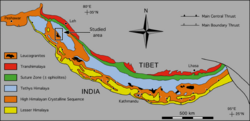

The Qiantang terrane is one of three main west-east-trending terranes of the Tibetan Plateau.
Contents
During the Triassic, a southward-directed subduction along its northern margin resulted in the Jin-Shajing suture, the limit between it and the Songpan-Ganzi terrane. During the Late Jurassic and Early Cretaceous, the Lhasa terrane merged with its southern margin along the Bangong suture. [1] This suture, the closure of part of the Tethys Ocean, transformed the Qiantang terrane into a large-scale anticline. [2] The merging of the Lhasa and Qiangtang terranes resulted in the uplift of a palaeoplateau known as the Qiangtang Plateau, [3] which rapidly thinned later in the Cretaceous. [4]
The Qiantang terrane is now located at c.5,000 m (16,000 ft) above sea level, but the timing of this uplift remains debated, with estimates ranging from the Pliocene-Pleistocene (3–5 Mya) to the Eocene (35 Mya) when the plateau was first denudated. [5]